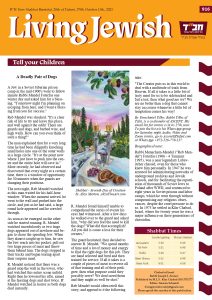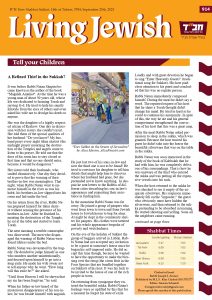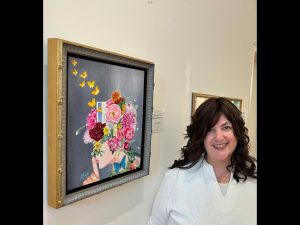News & Events
Uplift Magazine
Everyone has an obligation to explain the significance of Yetziat Mitzrayim (leaving Egypt). I heard a great dvar Torah by Rabbi Yitzchok Breitowitz. He says that each person must regard themself as though they were personally liberated from Mitzrayim. I, therefore, must regard myself as though I personally experienced being a slave in Mitzrayim. The Brisker Rav says this is the hardest mitzvah. How can I regard myself as a slave? Most of us were never in Mitzrayim, and I certainly wasn’t a slave. It was so long ago. What does it have to do with me?
The name “Mitzrayim” comes from the word m’tzarim (constrictions, boundaries). Every person has their own Mitzrayim: the Mitzrayim of arrogance, the Mitzrayim of laziness, the Mitzrayim of anger, the Mitzrayim of depression, the Mitzrayim of self-loathing and lack of self-esteem, etc. And when Hashem redeemed us from Mitzrayim, he gave us a koach (a special strength) that says, “I can be liberated from my own inner Mitzrayim. I can be free from my own inner slavery.”
There are three requirements to the Seder: Pesach, matzah and maror.
For maror, we eat something bitter to remember the slavery. The first step to being able to leave Mitzrayim is to honestly recognise that you are in slavery. As long as you don’t recognise that something is wrong, and just live in denial, you cannot be free. The first step in finding your way is to be honest with yourself and admit that you’re lost. Until you admit that you’re lost, there’s no way to get back on the right path. That is maror. Taste the bitter slavery and acknowledge it. But that’s not enough. Acknowledging alone isn’t enough. Some people are in psychotherapy for years and know every problem they have but do nothing about them.
And that’s where matzah comes in. The Maharal points out that one of the differences between matzah and chametz is that chametz represents inertia. You don’t need to do anything. Chametz is what happens by itself. Matzah requires taking an action and baking it. So, if maror represents recognising the problem, then matzah says, “Take some action to address it.” We all have moments of inspiration. Unless we do something, even just a small action, it’s meaningless. Inspiration comes and goes. In order for it to stick, we must concretise the it and take action.
Pesach has many symbolic meanings. The Korban Pesach (Pesach offering) always had to be shared with other people. You weren’t allowed eat it alone. If I want to leave my Mitzrayim and develop my relationship with Hashem, I need to be connected to other people. I need to have friends. In Kohelet it says that two are better than one. Why? Because if one falls, the other will pick him up. In her moments of weakness, I will pick my friend up, and in my moments of weakness, my friend will pick me up. This “friend” could be your husband, a group of friends or your community.
Acknowledge the slavery, take decisive action and be a part of a community. First I have to face the maror and take action with the matzah in order to make changes. If we just eat the maror right away, we can get depressed. We can lose hope, we can feel overwhelmed and we can become immobilised. We need to absorb the lesson of the matzah, and only then can we face the maror. We then combine the problem and the solution, as in the korech sandwich. Each of us has to experience our own Yetziyat Mitzrayim.
Every year around Pesach time I begin to feel like I need to let go. Let go of the beliefs that terrify me, paralyse me and hold me prisoner. I see it as luggage we hold on to forever.
Every time we get hurt and hold on to that pain, we suffer a little more. It weighs us down in so many ways. For me, at different times in my life, different experiences weighed me down. I had some bad experiences when I was younger that left me with PTSD. I would picture myself being attacked all the time. How would I get out of it? How would I escape?
Twenty-six years ago I went to Israel, to a little yishuv in Gaza, to stay with my brother and his family. As we drove, different family members pointed out the burnt-out car on the side of the road that had been ambushed by Arabs who had thrown Molotov cocktails at the poor family inside, who were just driving home. They told me of those who were murdered in the yishuv and of the time some Arabs sent a donkey with explosives but accidentally blew up the Mercedes instead. Baruch Hashem only the donkey made it into the yishuv, somehow depositing the explosives by the Mercedes. I remember all the Israeli kids would play with that donkey. They named him Arafat. Until one day an Arab came to the checkpoint and claimed that it was his donkey. The yishuv returned the donkey to him.
Arriving from the States, still a slave to my fears, I could feel my anxiety mounting. I knew I wasn’t going to make it here. My mother, who was born in Egypt and speaks Arabic fluently, would tell us what they were saying on the loudspeakers around the yishuv: “You must kill the Jew…” There was no wall separating us. There was just a chain link fence between “us” and “them”. We could see each other. Terrified, I reached my breaking point. I looked up to the sky and I said, “Hashem, I can’t… I can’t do it anymore. My bag of fears is too heavy! I just can’t carry it any more. I need you to carry it.” And Hashem did just that. And I let go! I was able to breathe again. I no longer pictured myself being attacked. I let go. That month ended up being the greatest catalyst for change in my life. I spoke to Hashem every day and found Him everywhere and in everything.
I once heard Rabbi Avraham Twerski describe how a lobster grows. The lobster is a soft, mushy animal with a hard, rigid shell. As the lobster grows, the shell becomes very confining. When the lobster feels uncomfortable under pressure, it hides under rocks and comes out of its shell and forms a new one. Every time this lobster attempts to grow, it becomes uncomfortable. It has to break through the hard exterior, “its Mitzrayim”, to form a new shell. The lobster does this many times. The stimulus for the lobster to grow is that it feels uncomfortable. If the lobster took a Zanex, or Valium, or some other drug to alleviate its discomfort, it wouldn’t grow.
Sometimes that uncomfortable Mitzrayim is what we need to help us get there. What is your Mitzrayim? Will you set yourself free?
In this painting here, the woman is trying to squeeze through her Mitzrayim and set herself free. In order to do this, she must let go of all that doesn’t serve her well. Sometimes we carry too much baggage. First, little bags from our childhood, then bigger bags through adulthood. Let go and enjoy the freedom! Wishing you all a happy, kosher Pesach






